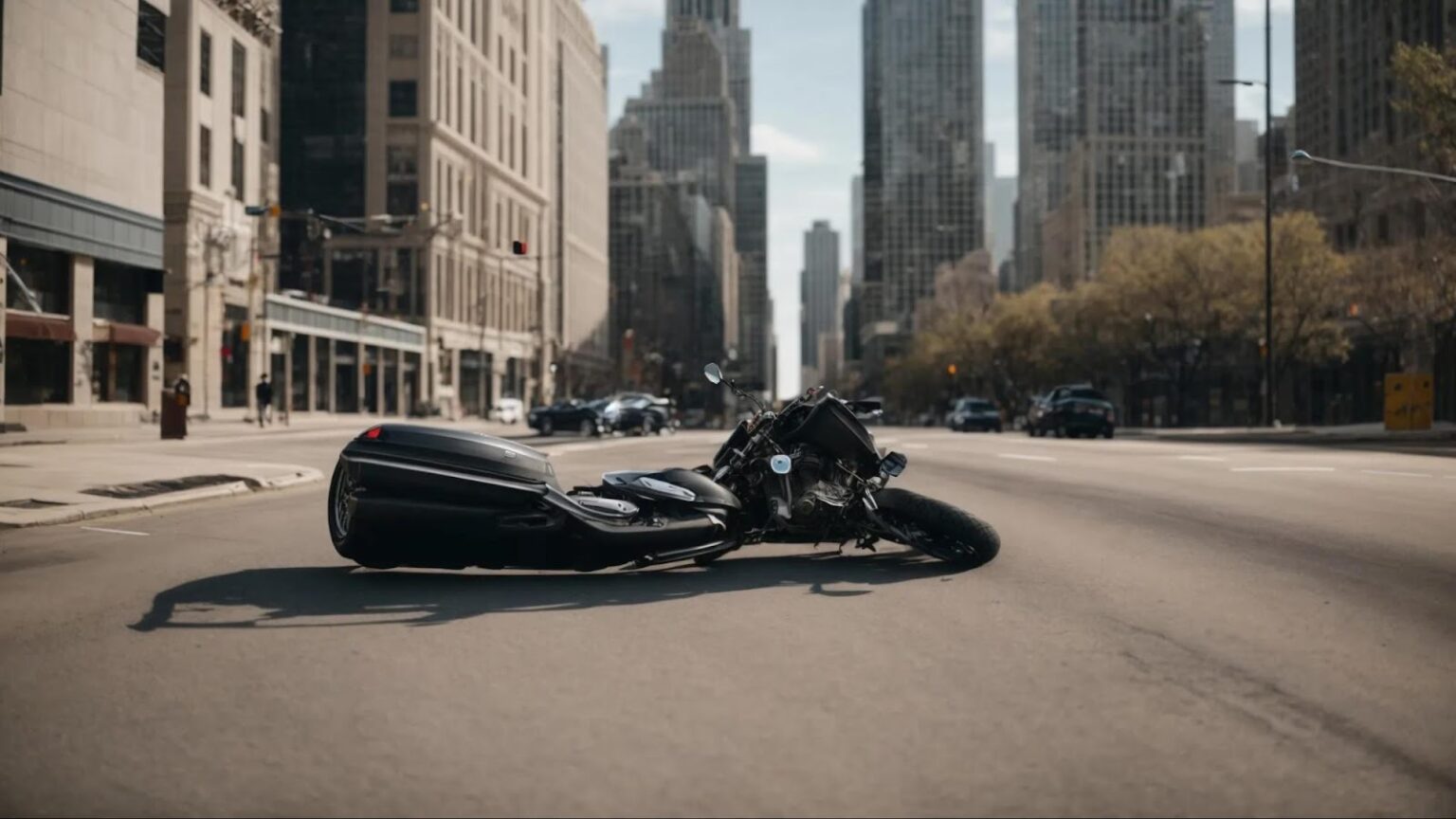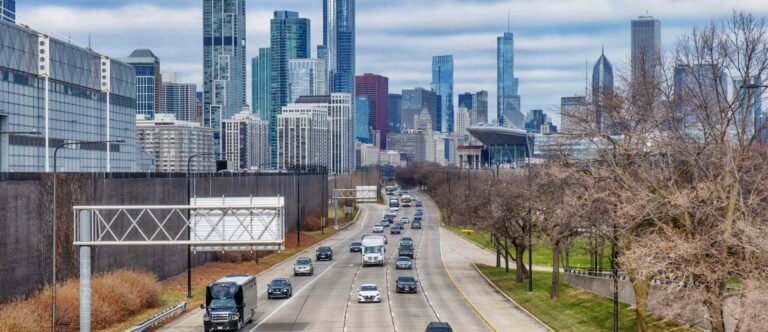Understanding Common Motorcycle Accidents in Chicago
Navigating the bustling streets of Chicago on a motorcycle comes with its own set of challenges and dangers.
The thrill of riding on two wheels is often overshadowed by the risk of accidents, especially at high-risk intersections and when speed limits are ignored.
Understanding the common causes of motorcycle accidents, from the effects of alcohol and drugs to the hazards of distracted driving, is crucial for motorcyclists to protect themselves and others.
In this article, we’ll delve into the details, offering insights and advice to keep Chicago’s two-wheeled community safe.
Keep reading to arm yourself with knowledge and learn how to reduce the risk of becoming a statistic on the city’s roads.
Key Takeaways
- High-Risk Intersections in Chicago Pose Significant Dangers to Motorcyclists Due to Factors Like Traffic Volume and Poor Road Conditions
- Defensive Driving and Enhanced Visibility Are Crucial Strategies for Motorcyclists to Navigate These Perilous Areas Safely
- Observing Speed Limits Is Essential for Reducing the Risk of Motorcycle Accidents and the Severity of Injuries
- Distracted Driving, Poor Road Conditions, and Unpredictable Weather Dramatically Increase the Risk of Motorcycle Accidents
- Riding Under the Influence Has Severe Legal Repercussions and Poses a High Risk to the Safety of the Rider and Others on the Road
The High-Risk Intersections for Motorcyclists in Chicago
Ensuring safety precautions are followed. If an incident occurs, contact a trusted personal injury lawyer.
Motorcycle accidents in Chicago reveal a troubling pattern, particularly when it comes to navigating the city’s bustling intersections.
A detailed analysis showcases that certain crossroads stand out as particularly perilous for riders, with factors such as high traffic volume, inadequate signage, and poor road conditions substantially elevating the risk of a collision.
Unraveling the complexities behind why these intersections pose such a significant threat becomes essential for motorcyclists aiming to traverse the city’s streets safely.
Equipped with this knowledge, riders can adopt specific strategies designed to mitigate these dangers, empowering them to navigate high-risk zones with augmented safety and confidence.
This section delves into identifying the intersections that every motorcyclist in Chicago should approach with caution, elucidating the underlying risks and offering practical tips for safe passage.
Identifying Most Dangerous Intersections
Chicago’s bustling streets and dense traffic conditions paint a complex tapestry for motorcyclists, where navigating through can be akin to steering through a maze fraught with potential hazards. Identifying the most dangerous intersections becomes a critical task for riders aiming to enhance their safety. High-risk intersections are often characterized by factors such as frequent traffic congestion, limited visibility due to poorly placed signage or obstructions, and a high incidence of distracted driving behaviors among motorists:
- The convergence of major avenues where the volume of both pedestrian and vehicular traffic spikes, significantly increasing the risk of accidents.
- Intersections near highways or off-ramps, where the speed differential between motorcycles and other vehicles can lead to severe miscalculations and collisions.
- Areas surrounding construction zones where temporary traffic patterns, debris, and uneven road surfaces pose unique challenges to motorcycle stability and maneuverability.
Tips for Navigating High-Risk Zones Safely
Navigating high-risk zones in Chicago necessitates a proactive approach to ensure safety for motorcyclists: starting with heightened awareness and defensive driving techniques. Motorcyclists are encouraged to keep a keen eye on the behaviors of other drivers, anticipate potential hazards, and maintain a safe distance from vehicles, especially in intersections known for their complexity and risk. Employing these strategies equips riders with the necessary tools to maneuver through challenging zones while minimizing the risk of accidents.
- Master defensive driving skills to anticipate and respond to the unpredictable actions of other motorists and pedestrians.
- Enhance visibility by wearing reflective gear and ensuring motorcycle lights are functioning properly, especially when riding at dawn, dusk, or night.
- Approach intersections with caution, reducing speed and being prepared to stop or adjust course quickly in response to sudden changes in traffic flow or road conditions.
Common Causes of Motorcycle Accidents in Chicago
In the bustling streets of Chicago, motorcyclists face an array of hazards, each contributing uniquely to the incidences of traffic collisions.
Central to these dangers are the consequences of distracted driving, a prevalent issue that compromises road safety for all users, especially those on two wheels.
Additionally, the state of the roads themselves presents significant challenges; potholes, uneven surfaces, and abrupt changes in the road layout heighten the risk for riders, demanding superior navigation skills and constant vigilance.
Weather also plays a critical role in motorcycle safety, with conditions such as rain, ice, and strong winds creating perilous environments for those navigating the city’s thoroughfares.
These factors collectively underscore the complexities of riding in Chicago and set the stage for understanding the multifaceted nature of motorcycle accidents in the area.
Distracted Driving and Its Impact on Safety
Distracted driving emerges as a dominant factor precipitating motorcycle accidents in Chicago. The proliferation of mobile devices, alongside other distractions inside and outside the vehicle, diverts a driver’s focus from the road. This breakdown in attention substantially elevates the risk of a vehicle encroaching upon a motorcyclist’s lane or failing to yield, leading to severe, sometimes fatal, collisions.
| Factor | Impact on Motorcycle Safety |
|---|---|
| Distracted Driving | Increases likelihood of lane intrusion and failure to yield, endangering motorcyclists. |
The Effect of Poor Road Conditions
Poor road conditions, such as potholes, uneven surfaces, and abrupt changes in the layout, pose significant hazards to motorcyclists in Chicago. These imperfections can compromise a motorcycle’s stability and maneuverability, leading to loss of control and potential accidents. Consequently, the integrity of Chicago’s roadways directly impacts the safety of motorcyclists, underscoring the importance of regular maintenance and prompt repair of these thoroughfares.
Weather-Related Riding Challenges
Chicago’s unpredictable weather patterns present significant riding challenges for motorcyclists, magnifying the risk of accidents. Sudden rainfalls decrease visibility and road traction, increasing the likelihood of slips and falls, while icy conditions in winter lead to treacherous road surfaces that demand exceptional skill and caution from riders. Gusts of wind can also destabilize motorcycles, particularly on elevated roadways or when passing large vehicles, making the mastery of weather-related riding techniques essential for safety:
- Rain reduces visibility and traction, elevating the risk of losing control.
- Icy conditions render roads treacherously slick, demanding heightened caution.
- Wind gusts can destabilize motorcycles, especially in open or elevated areas.
The Role of Alcohol and Drugs in Motorcycle Crashes
The peril of motorcycle accidents in Chicago is significantly heightened when alcohol and drugs come into play, introducing a grave layer of risk not just to the impaired rider but to everyone sharing the road.
While the National Highway Traffic Safety Administration provides alarming statistics highlighting the prevalence of impaired riding accidents, understanding the prevention techniques and the stern legal repercussions of riding under the influence can act as effective deterrents.
Addressing these critical aspects offers a blueprint for riders to uphold not only their safety but also that of the broader community, underscoring the vital importance of sobriety behind the handlebars.
Statistics on Impaired Riding Accidents
Impaired riding significantly increases the risk of motorcycle accidents in Chicago, with the National Highway Traffic Safety Administration highlighting that alcohol and drugs impair cognitive functions, reaction times, and overall motor control. These substances contribute to a disturbing number of traffic collisions, underscoring the severity of riding under the influence. This data not only sheds light on the extent of the issue but also emphasizes the critical need for increased awareness and preventive measures among the motorcycling community.
Prevention Tips for Riders and Awareness
To mitigate the heightened risk of accidents due to impaired riding, Walner Law emphasizes the importance of riders maintaining sobriety at all times on the road. Educating the motorcycling community on the potential legal repercussions and personal dangers of driving under the influence forms a critical component of their awareness campaigns. Walner Law advocates for the use of designated drivers or alternative transportation methods after consumption of alcohol or drugs, reinforcing the message that safety begins with responsible riding practices.
Legal Consequences of Riding Under the Influence
The legal consequences of riding under the influence in Chicago are stringent and designed to deter this dangerous behavior effectively: penalties can range from significant fines, and license suspension, to even imprisonment. The severity of these sanctions underscores Illinois’ commitment to maintaining road safety and serves as a critical reminder to all motorcyclists about the importance of sober riding.
| Consequence | Impact on Rider |
|---|---|
| Significant Fines | Financial burden and potential long-term financial implications. |
| License Suspension | Loss of driving privileges, affecting mobility and possibly employment. |
| Imprisonment | Direct impact on freedom and long-lasting legal and social repercussions. |
Conclusion
Understanding common motorcycle accidents in Chicago is paramount for enhancing rider safety and navigating the city’s challenging streets.
Identifying high-risk intersections and factors like high traffic volumes, poor road conditions, and distracted driving helps motorcyclists adopt proactive strategies, such as defensive driving and speed management, to reduce the likelihood of accidents.
Weather conditions also demand tailored riding techniques to maintain control.
Furthermore, recognizing the dangerous implications of impaired riding, through alcohol or drugs, underscores the necessity of sobriety for the wellbeing of all road users.
By grasping these aspects, motorcyclists can significantly mitigate risks, ensuring a safer riding experience in Chicago’s bustling environment.


 Skip to content
Skip to content







